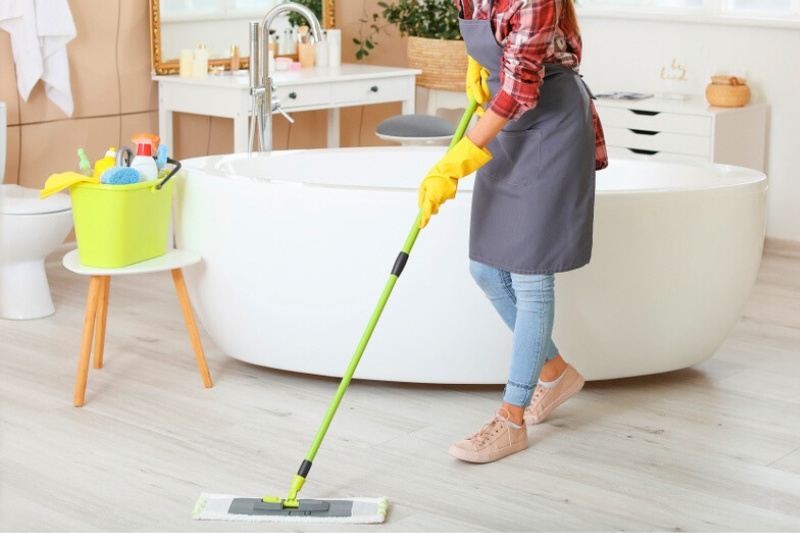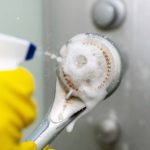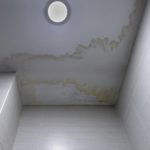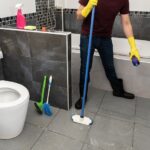Maintaining a hygienic bathroom is crucial for the health, safety and comfort of everyone living in your home.
Whether you’re a household of one or a bustling family, understanding the importance of regular bathroom cleaning is key to preventing the spread of germs and illnesses.
Bathrooms are common breeding grounds for various bacteria, such as Bacteroidaaceae (commonly associated with faecal matter), E.coli, Streptococcus, and Salmonella. These microorganisms can pose serious health risks if a bathroom isn’t sufficiently cleaned.
By keeping your bathroom clean, you not only limit the spread of these germs but also ensure a safe and hygienic space that can be used daily by all.
The general recommendation is to clean the bathroom at least once a week. However, some areas require more frequent attention.
For example, cleaning the toilet seat, ensuring handles are wiped down, and keeping the tiles and grout fresh and moisture-free are tasks you can carry out more often.
Of course, there are factors that can influence this weekly cleaning job. These are:
- The number of people living in your house. The more people, the more cleaning you will have to do.
- Personal preference plays a role. Some cleaning tasks don’t have to be done every day, but you may prefer to carry out the activities daily. It all boils down to how clean you want your bathroom to be.
- If someone is sick. If a person is unwell, you need to clean the bathroom more often to prevent the spread of germs between members of the household.
Let’s look at this in more detail.
How Often Are You Supposed to Clean a Bathroom?
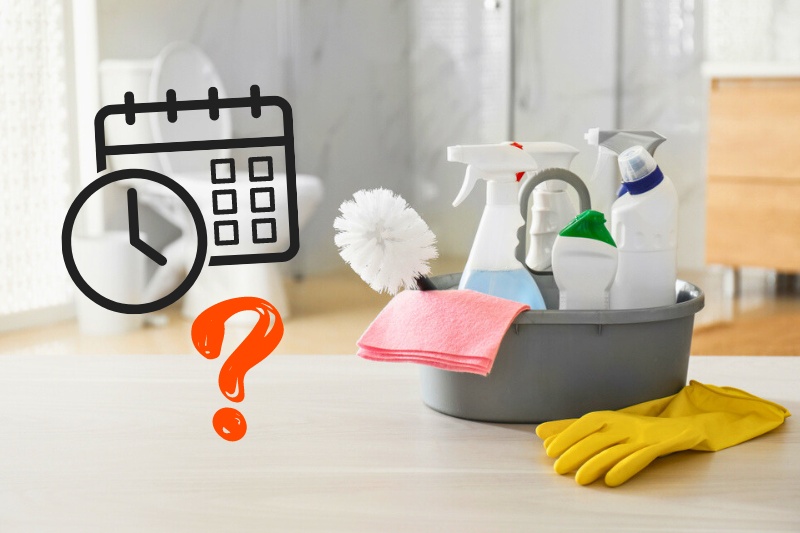
As mentioned above, you should clean your bathroom at least once a week. However, depending on your home situation and what’s going on at the time, you might have to adjust the schedule below ever so slightly!
Everyday cleaning jobs
The everyday cleaning tasks mentioned below are jobs you can carry out right after you’ve completed an action in the bathroom.
For example, you can squeegee the water off the walls straight after you’ve come out of the shower and dried yourself.
These daily tasks will help to keep the germs at bay in the most used areas – toilet, shower and sink.
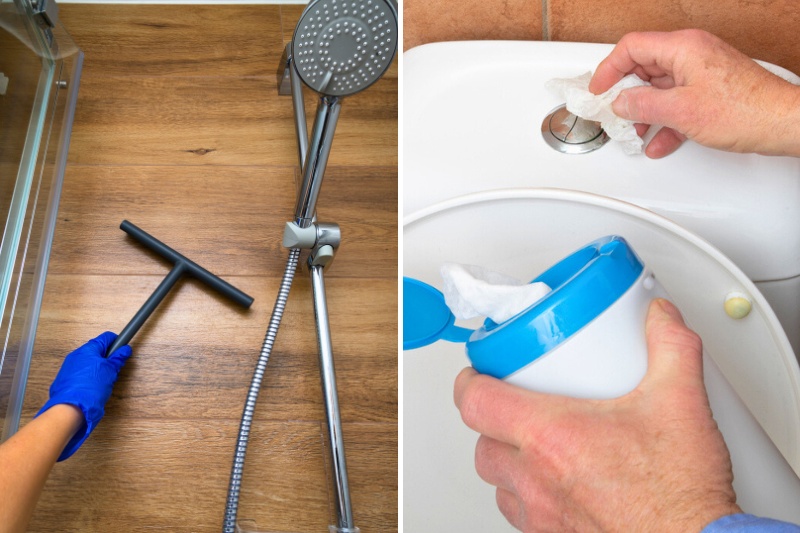
Here are some daily tasks:
- After taking a shower or bath, squeegee excess moisture off the surfaces. This includes the tiles, shower door and mirror. This will prevent mould and mildew from putting in an appearance.
- Remove excess toothpaste from the sink after you’ve brushed your teeth.
- Give the toilet seat, the part you sit on, a wipe down with a multipurpose wipe. You can do this first thing in the morning so the seat is ready for the day ahead. It also means that you wipe up any drips someone may have left behind after going to the loo during the night.
- Make sure the flush handle is clean. With an average of 83 bacteria per square inch, the handle isn’t the grimiest spot in the bathroom, but it does need to be cleaned regularly. After all, we all flush the toilet after we’ve used it (well, hopefully!), so you can easily spread different types of dirt and bodily fluids over the handle. That’s definitely something you don’t want to spread around!
- Wipe the countertops in your bathroom down with an antibacterial wipe. This quick clean will ensure you’ve mopped up any spillages and that the surface is hygienic.
Tip: If you stay on top of the general maintenance, cleaning the entire bathroom won’t seem like a mammoth task! Make sure you carry out those mini spot cleans each day!
Twice to three times a week jobs
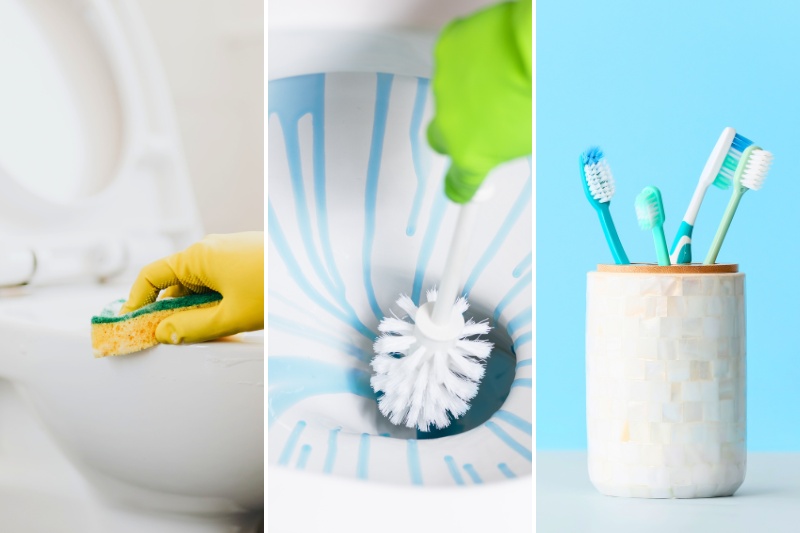
Some of the jobs listed below can be carried out daily if you like, particularly if you or someone you live with is unwell.
Here are some twice to three times a week tasks:
- According to research, a toilet seat is covered in 295 bacteria per square inch. To keep these germs at bay, clean the entire toilet seat multiple times throughout the week to ensure it is hygienic for all. You should lift the seat and clean all sides of it.
- In addition to the toilet seat, you should clean the toilet bowl. A staggering 2 million bacteria per square inch live and breed in your toilet bowl. You can keep your loo hygienic by popping some toilet cleaner, like Harpic or Toilet Duck, down the pan to keep it fresh, germ-free and limescale-free.
- A whopping 200,000 bacteria per square inch can thrive on your toothbrush and in the holder you use. That’s more than what’s down the toilet! So, ensure you empty and rinse your toilet holder multiple times a week to keep it fresh and stop the horrible, slimy gunk from pooling at the bottom of the pot. It’s also worth cleaning your toothbrush too! But you should do this anyway because you brush your teeth daily.
- Giving the light switch a quick clean with an antibacterial wipe is a quick win. An average of 217 bacteria per square inch can be found on the switch. Since some people skip washing their hands after going to the loo, it would be wise to clean this area frequently.
Tip: Keep some Dettol Antibacterial wipes in the bathroom so you can quickly wipe down the surfaces mentioned above.
Once-a-week jobs
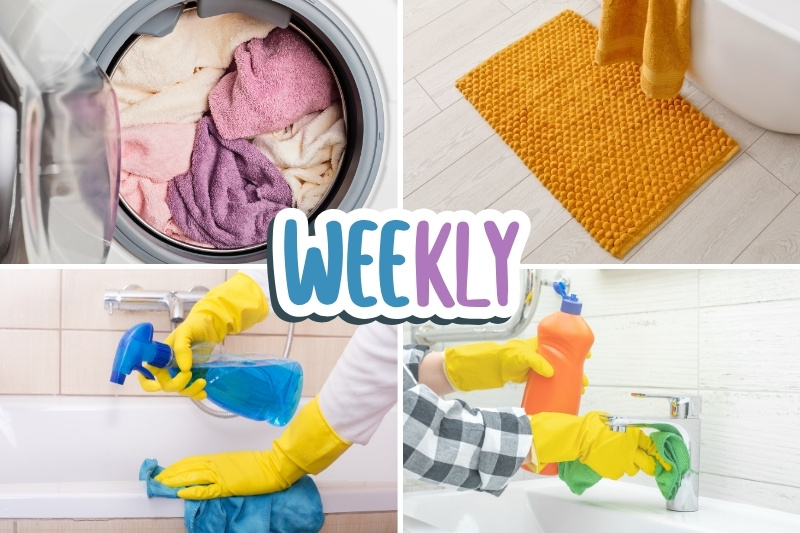
The once-a-week jobs below will ensure your bathroom is free from as much bacteria as possible. It’ll also look clean and clutter-free and be safe for you and the family. You shouldn’t skip any of the jobs mentioned below!
Some of the jobs listed below may need to be done more than once a week. This depends on how many people live in the house and your personal cleaning routine.
For example, bathroom mirrors often get splattered with toothpaste, so you might have to wipe the surface down more than once in a seven-day period.
Here are some once-a-week tasks:
- Clean used towels that have been left in the bathroom.
- Wash the shower mat and bath mat. Read our guide on how to clean a bath mat if you’re not sure how.
- Give the shower tray and bathtub a good scrub. To make your job easier, consider buying some extending scrubbing tools so you can reach up high and down low. Pair the tools with bathroom cleaning fluid, like Flash Bathroom, to work that grime out.
- Clean the drains and plugholes. The average plughole contains 120,000 bacteria per square inch, so it’s imperative that you clear out the germs using a drain unblocker. Also, remove any hair from the drains, as this can cause a backup of water in the shower tray/tub. If you’ve got a lot of hair trapped around the plughole, consider buying a drain protector (take note of what shape drain you have, then purchase a suitable hair catcher).
- On average, there are 6,267 bacteria per square inch on your taps, so they need to be wiped down on a regular basis. Many germs get onto taps, including toilet-related ones, bodily fluids, and toothpaste. So, cleaning them is key!

- Clean the mirror in the bathroom so you can see your reflection properly. You’ll also be able to remove any toothpaste stains, hair products, or makeup from the surface.
- Wet clean and hoover the floor. Nobody wants to stand on a dirty floor when they exit the shower! To clean the floor, mix some off-the-shelf floor cleaner in a bucket of water and start mopping! When hoovering, make sure you use the correct attachment for the floor; you don’t want to scratch the surface.
- Make sure the shower curtain/glass door is clean. Curtains, in particular, start to get mouldy at the bottom, so shake them out after you’re done using the shower and allow the moisture to run off them. It is possible to clean some shower curtains, but sometimes it’s easier to replace them! Doors will need to be cleaned with a glass cleaner and a squeegee.
- Clean your tiles, grout, and sealant around the tray/tub to keep them free from germs and mildew.
Monthly jobs
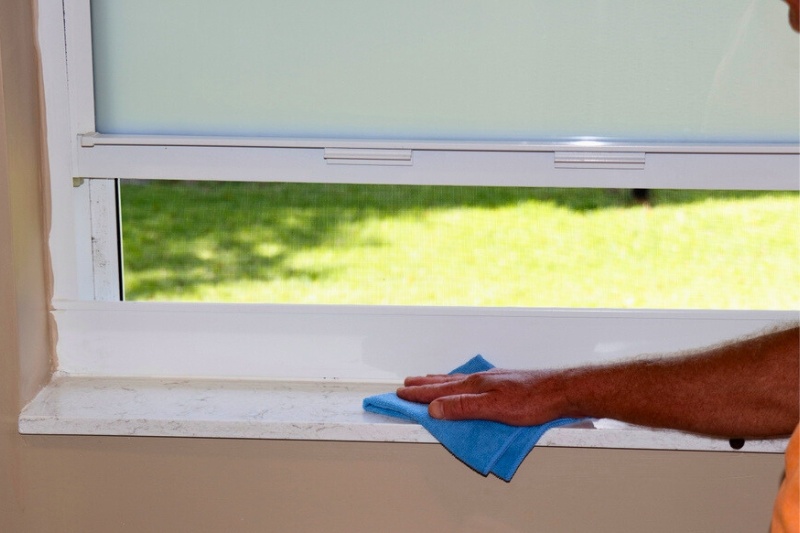
Monthly jobs are the kind that ensures your bathroom remains fresh and isn’t bogged down with dust and the like.
Some of the jobs mentioned below can be done every two months or so if you’d prefer.
However, staying on top of the jobs is better so your bathroom remains clean. Also, the more often you carry out these tasks, the faster you’ll get at doing them.
Here are some monthly tasks:
- Give the windows a clean, including the tracks.
- Make sure the window sill is dust-free.
- Clean the blinds.
- Declutter cupboards to stay on top of the mess. Throw out products that are half used or have gone off.
- Get the outside of the windows cleaned by a professional window cleaner.
Every two to three months
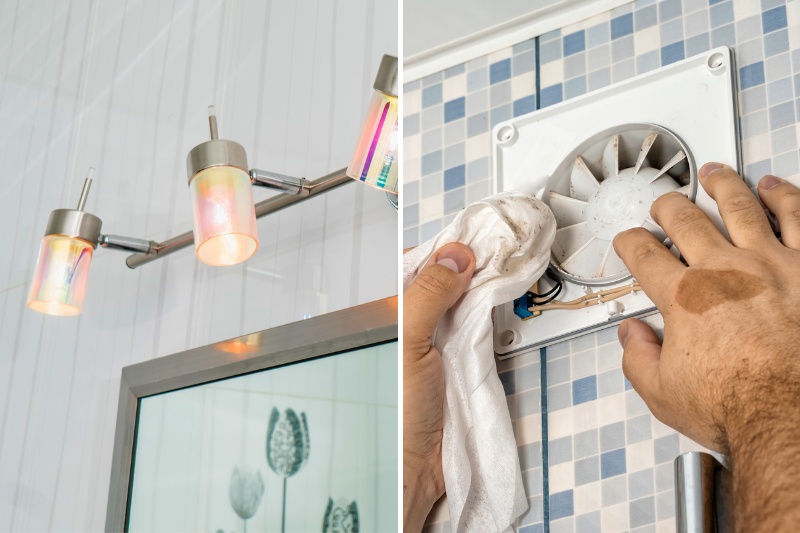
The following tasks can be carried out less frequently because you don’t come into much contact with the surfaces mentioned, so they’re not likely to be covered in as much bacteria as some of the surfaces mentioned above.
If it’s easier, carry out the tasks mentioned below when you complete the ‘monthly tasks’ noted above.
Here are some two to three month tasks:
- Clean the light fitting(s).
- Ensure the extractor fan is dust-free.
- Dust ornaments and plants that you keep in the bathroom.
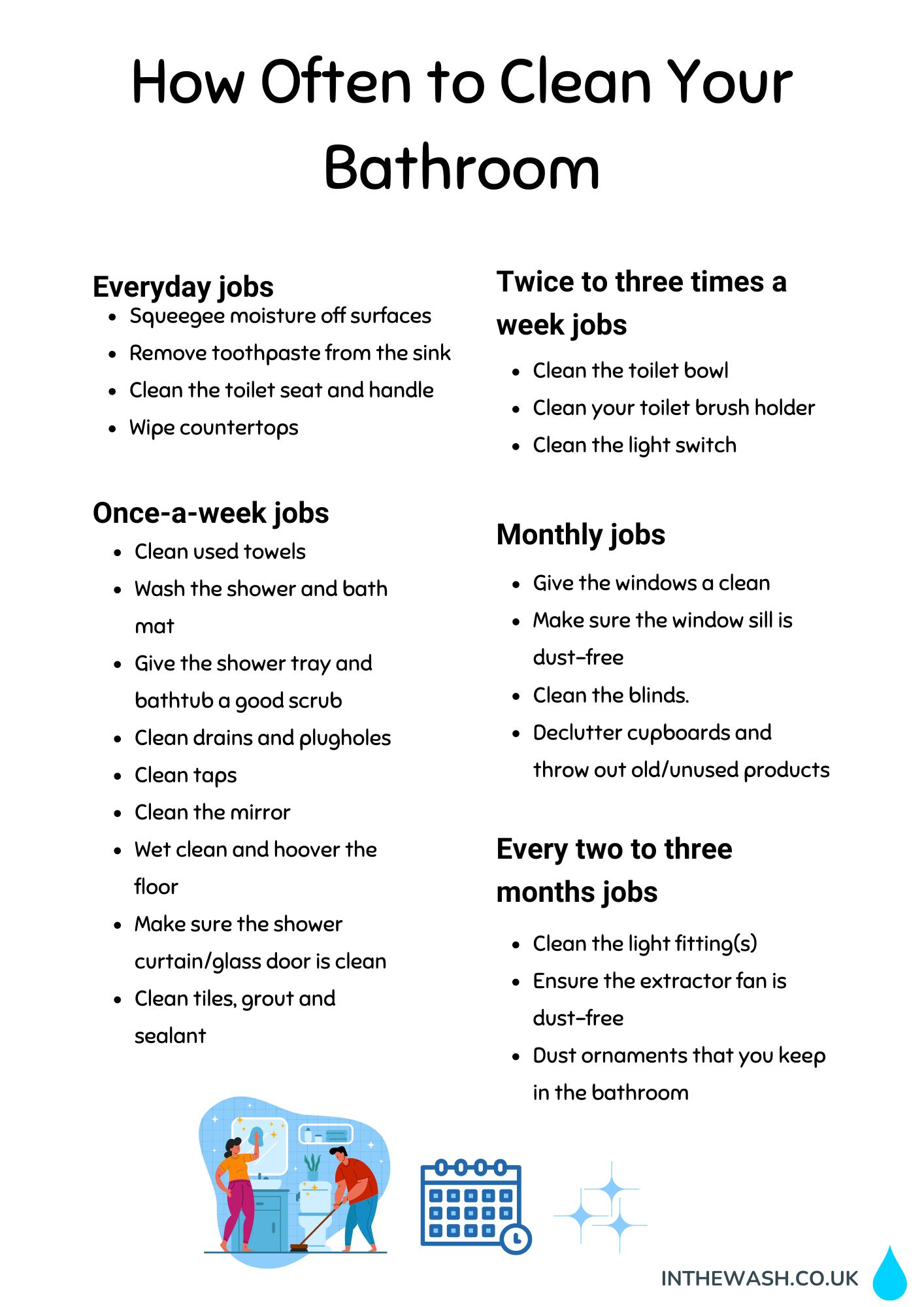
A Brief Guide on How to Clean a Bathroom
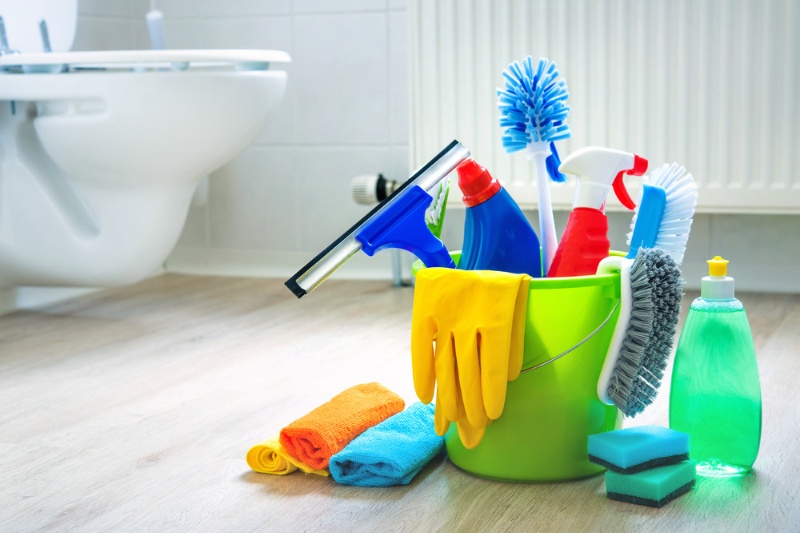
Step 1: Gather your supplies
You will likely need to use the following:
- Toilet brush
- Toilet cleaner
- Drain cleaner
- Multipurpose wipes
- Rubber gloves
- Tile cleaner
- Grout cleaner
- Glass cleaner
- Vacuum cleaner
- Scrubbing tools/brush
- Mop and bucket
- Multipurpose bathroom cleaning spray
Step 2: Clear the space
Remove the towels, bath mats and other objects scattered on the floor. In the case of towels and mats, you can stick them in the washing machine to clean them!
Step 3: Decide how you will clean the bathroom
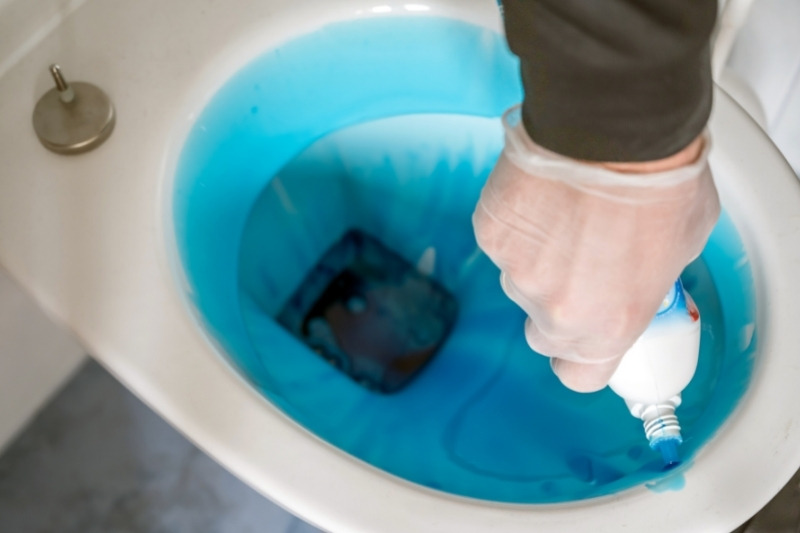
The next step is to decide what order you will clean things in. In general, you need to:
- Carry out basic background tasks. For example, pop some toilet cleaner in the toilet or place a drain unblocker down the drain so they can start breaking down the bacteria as you clean the other areas in your bathroom.
- Start from the top of the room and work towards the bottom.
- Clean the tiles, grout and sealant.
- Clean the shower head, door or curtain.
- Wash the bath taps.
- Remove the dirt and soap scum from the shower tray or bathtub.
- Wipe down mirrors.
- Clean the windows and sills.
- Clean the toilet, including the seat, under the seat, the cistern and the handle.
- Clean the toothbrush holder.
- Remove clutter from cupboards.
- Empty the rubbish bin.
- Clean the floor – hoover dry dirt away, then mop the floor. If need be, hoover the floor again when it is dry.
- Allow the area to dry naturally – open a window.
- Throw out dirty tools.
Note: Depending on the set-up of your bathroom, some of the steps might not apply to you, and you can also alter the steps to suit your cleaning routine.
Step 4: Clean the room
Once you’ve got your tools and plan of action ready, you can crack on with the cleaning work!
To start with, you might take a long time to clean your bathroom. But with time, you will speed up. Doing micro cleans in between deep cleans will also speed up your overall cleaning process.
Step 5: Sit back and admire your hard work!
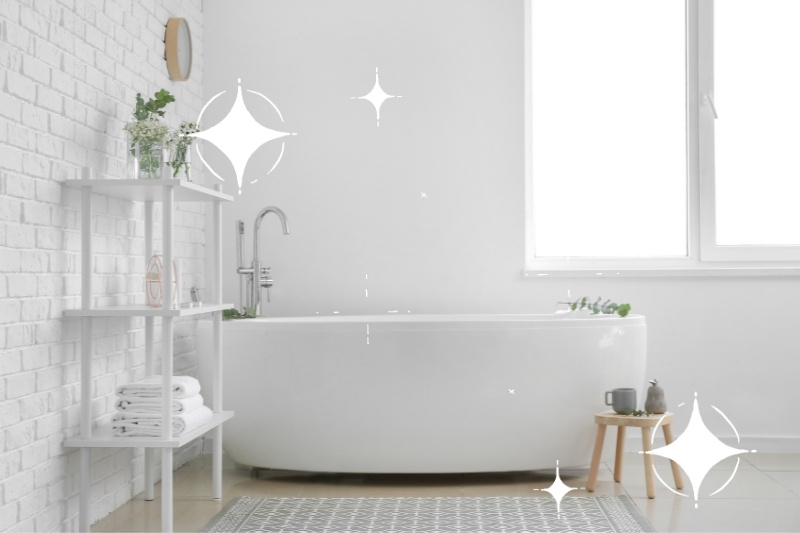
As a last step, you can make sure that everything is back in its place and that you’re happy with the work that’s been carried out.
It’s now time for a cup of tea. Throw in a digestive biscuit too!

Bethan has a passion for exploring, reading, cooking and gardening! When she’s not creating culinary delights for her family, she’s concocting potions to keep her house clean!
